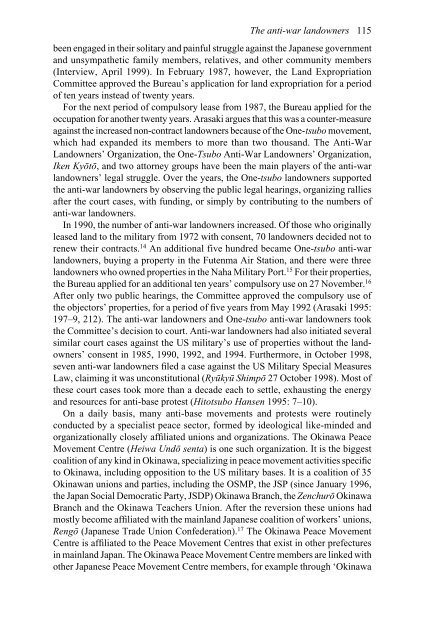Myth, Protest and Struggle in Okinawa
Myth, Protest and Struggle in Okinawa
Myth, Protest and Struggle in Okinawa
Create successful ePaper yourself
Turn your PDF publications into a flip-book with our unique Google optimized e-Paper software.
The anti-war l<strong>and</strong>owners 115<br />
been engaged <strong>in</strong> their solitary <strong>and</strong> pa<strong>in</strong>ful struggle aga<strong>in</strong>st the Japanese government<br />
<strong>and</strong> unsympathetic family members, relatives, <strong>and</strong> other community members<br />
(Interview, April 1999). In February 1987, however, the L<strong>and</strong> Expropriation<br />
Committee approved the Bureau’s application for l<strong>and</strong> expropriation for a period<br />
of ten years <strong>in</strong>stead of twenty years.<br />
For the next period of compulsory lease from 1987, the Bureau applied for the<br />
occupation for another twenty years. Arasaki argues that this was a counter-measure<br />
aga<strong>in</strong>st the <strong>in</strong>creased non-contract l<strong>and</strong>owners because of the One-tsubo movement,<br />
which had exp<strong>and</strong>ed its members to more than two thous<strong>and</strong>. The Anti-War<br />
L<strong>and</strong>owners’ Organization, the One-Tsubo Anti-War L<strong>and</strong>owners’ Organization,<br />
Iken Kyōtō, <strong>and</strong> two attorney groups have been the ma<strong>in</strong> players of the anti-war<br />
l<strong>and</strong>owners’ legal struggle. Over the years, the One-tsubo l<strong>and</strong>owners supported<br />
the anti-war l<strong>and</strong>owners by observ<strong>in</strong>g the public legal hear<strong>in</strong>gs, organiz<strong>in</strong>g rallies<br />
after the court cases, with fund<strong>in</strong>g, or simply by contribut<strong>in</strong>g to the numbers of<br />
anti-war l<strong>and</strong>owners.<br />
In 1990, the number of anti-war l<strong>and</strong>owners <strong>in</strong>creased. Of those who orig<strong>in</strong>ally<br />
leased l<strong>and</strong> to the military from 1972 with consent, 70 l<strong>and</strong>owners decided not to<br />
renew their contracts. 14 An additional five hundred became One-tsubo anti-war<br />
l<strong>and</strong>owners, buy<strong>in</strong>g a property <strong>in</strong> the Futenma Air Station, <strong>and</strong> there were three<br />
l<strong>and</strong>owners who owned properties <strong>in</strong> the Naha Military Port. 15 For their properties,<br />
the Bureau applied for an additional ten years’ compulsory use on 27 November. 16<br />
After only two public hear<strong>in</strong>gs, the Committee approved the compulsory use of<br />
the objectors’ properties, for a period of five years from May 1992 (Arasaki 1995:<br />
197–9, 212). The anti-war l<strong>and</strong>owners <strong>and</strong> One-tsubo anti-war l<strong>and</strong>owners took<br />
the Committee’s decision to court. Anti-war l<strong>and</strong>owners had also <strong>in</strong>itiated several<br />
similar court cases aga<strong>in</strong>st the US military’s use of properties without the l<strong>and</strong>owners’<br />
consent <strong>in</strong> 1985, 1990, 1992, <strong>and</strong> 1994. Furthermore, <strong>in</strong> October 1998,<br />
seven anti-war l<strong>and</strong>owners filed a case aga<strong>in</strong>st the US Military Special Measures<br />
Law, claim<strong>in</strong>g it was unconstitutional (Ryūkyū Shimpō 27 October 1998). Most of<br />
these court cases took more than a decade each to settle, exhaust<strong>in</strong>g the energy<br />
<strong>and</strong> resources for anti-base protest (Hitotsubo Hansen 1995: 7–10).<br />
On a daily basis, many anti-base movements <strong>and</strong> protests were rout<strong>in</strong>ely<br />
conducted by a specialist peace sector, formed by ideological like-m<strong>in</strong>ded <strong>and</strong><br />
organizationally closely affiliated unions <strong>and</strong> organizations. The Ok<strong>in</strong>awa Peace<br />
Movement Centre (Heiwa Undō senta) is one such organization. It is the biggest<br />
coalition of any k<strong>in</strong>d <strong>in</strong> Ok<strong>in</strong>awa, specializ<strong>in</strong>g <strong>in</strong> peace movement activities specific<br />
to Ok<strong>in</strong>awa, <strong>in</strong>clud<strong>in</strong>g opposition to the US military bases. It is a coalition of 35<br />
Ok<strong>in</strong>awan unions <strong>and</strong> parties, <strong>in</strong>clud<strong>in</strong>g the OSMP, the JSP (s<strong>in</strong>ce January 1996,<br />
the Japan Social Democratic Party, JSDP) Ok<strong>in</strong>awa Branch, the Zenchurō Ok<strong>in</strong>awa<br />
Branch <strong>and</strong> the Ok<strong>in</strong>awa Teachers Union. After the reversion these unions had<br />
mostly become affiliated with the ma<strong>in</strong>l<strong>and</strong> Japanese coalition of workers’ unions,<br />
Rengō (Japanese Trade Union Confederation). 17 The Ok<strong>in</strong>awa Peace Movement<br />
Centre is affiliated to the Peace Movement Centres that exist <strong>in</strong> other prefectures<br />
<strong>in</strong> ma<strong>in</strong>l<strong>and</strong> Japan. The Ok<strong>in</strong>awa Peace Movement Centre members are l<strong>in</strong>ked with<br />
other Japanese Peace Movement Centre members, for example through ‘Ok<strong>in</strong>awa
















